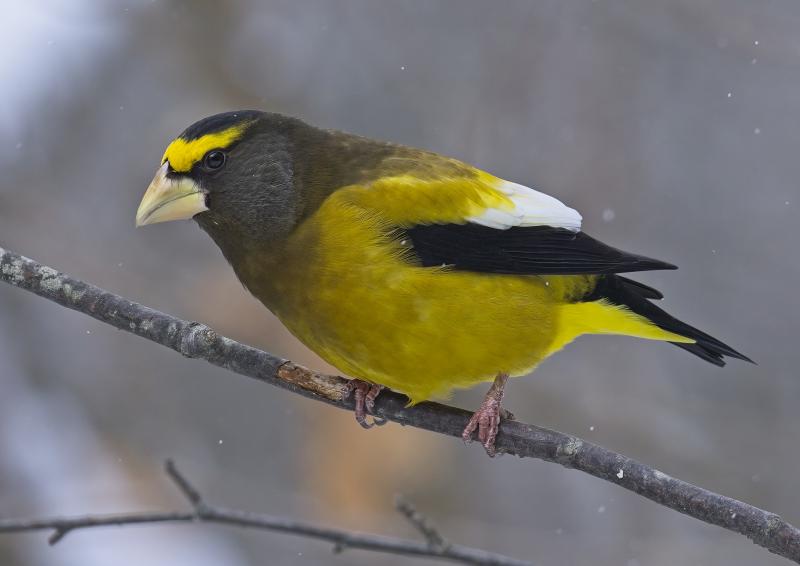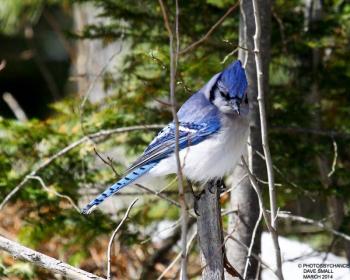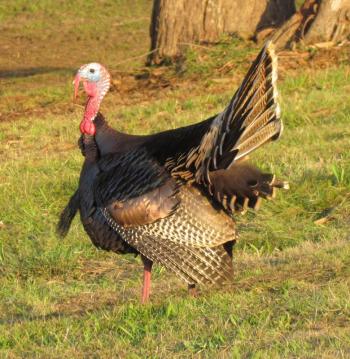We were driving on a rural road a few days ago when a flock of 30 or so wild turkeys came ambling slowly across in front of us, stopping traffic in both directions. Suddenly, a male turkey, his red wattles dangling on each side of his face, spread open his massive, golden-tipped tail and began slowly tilting it back and forth. Stunning! The hens didn’t seem that impressed, but we were!
The next day, at least two birders from southern Maine reported that they had heard the classic low, buzzy notes of the first displaying American woodcock of the season. Woodcock, with their long beaks, bulgy eyes and short legs, are a curious-looking bird—when you actually get to clearly see one. Most of the time they are seemingly invisible. Only when the males perform their bizarre displays at dusk are they easily detectable. As darkness falls, male woodcocks give their low “peent” calls from field edges, then fly high up into the air doing an elaborate sky dance while giving high-pitched twittering calls. All of this is done to attract female woodcock with whom to mate. Some males that are “attractive” may mate with many females; others that are less so, have fewer or options and maybe none at all. The males and females may never meet again as the males take no part in the incubating of eggs or care of young. Such an interesting bird with such an extravagant mating display.
People in other parts of the world find these birds and their behaviors exotic and exciting. Birders, too, from far beyond are borders are envious, and when they visit, seek out birds like these.
Yet we sometimes take them for granted.
Maine birders who were active before the successful reintroduction of wild turkey beginning in the 1970s and 1980s wouldn’t have taken them for granted. The species had then been absent from the state for at least 100 years. Imagine that!
We try not to take bald eagles for granted even though we see them just about everywhere nowadays. We well remember how excited we were 40 years ago whenever we saw one. Back then, there were fewer than 100 nesting pairs in the entire state of Maine. Now there are more than 700!
During winters in the 1970s and 1980s, many a backyard bird feeding station in Maine would become overrun with the dazzling yellow hues of evening grosbeaks, alighting on bird feedings in massive flocks. Some locations would play host to hundreds of these noisy, thick-billed birds at a time, their chiming calls becoming the background sound of a cold, snowy winter morning. How many of us took those birds for granted? At the family home in Winthrop, we recall Allison’s father noting how quickly he was going through seed during grosbeak visits. Who would have guessed then that their bubbling presence would ever become scant? We haven’t seen or heard an evening grosbeak in a several years, and we haven’t seen a decent sized flock of evening grosbeaks in decades.
We remember the rows of gourd-shaped mud nests of cliff swallows lined up under the eaves of barns, stables, and homes in midcoast Maine in the 1970s and 1980s. As the birds peeked out of the nests with their cream-colored foreheads and giving their characteristic creaky calls, it was easy to assume back then that they would always be there in abundance. The last ones we remember seeing in the midcoast region were some that nested for a while on the Pemaquid Point lighthouse museum.
Take a moment to look out at your bird feeder or around your yard. That chickadee, that mourning dove, that blue jay—please don’t take it for granted. It’s special, whether it’s a new species for a beginning bird watcher or for those who see it often. Let’s enjoy all that we see, and do what we can to ensure birds like these will be seen forever.
Jeffrey V. Wells, Ph.D., is a Fellow of the Cornell Lab of Ornithology and Vice President of Boreal Conservation for National Audubon. Dr. Wells is one of the nation's leading bird experts and conservation biologists. He is a coauthor of the seminal “Birds of Maine” book and author of the “Birder’s Conservation Handbook.” His grandfather, the late John Chase, was a columnist for the Boothbay Register for many years. Allison Childs Wells, formerly of the Cornell Lab of Ornithology, is a senior director at the Natural Resources Council of Maine, a nonprofit membership organization working statewide to protect the nature of Maine. Both are widely published natural history writers and are the authors of the popular books, “Maine’s Favorite Birds” (Tilbury House) and “Birds of Aruba, Bonaire, and Curaçao: A Site and Field Guide,” (Cornell University Press).


































